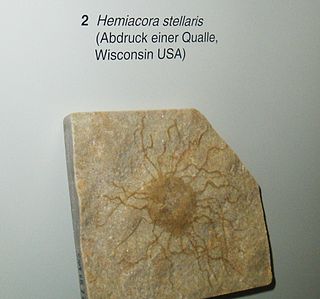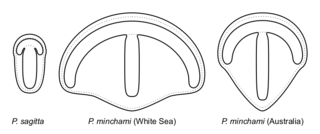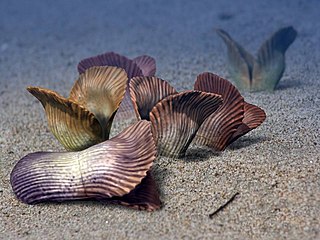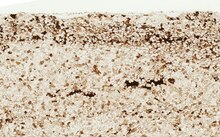
Dickinsonia is an extinct genus of lifeforms that lived during the late Ediacaran period in what is now Australia, China, Russia and Ukraine, most likely a basal animal. The individual Dickinsonia typically resembles a bilaterally symmetrical ribbed oval. Its affinities are presently unknown; its mode of growth has been considered consistent with a stem-group bilaterian affinity, but damaged specimens show recovery by apical meristems found only in plants and fungi. Also suggested has been an "extinct kingdom". The discovery of cholesterol molecules in fossils of Dickinsonia lends support to the idea that Dickinsonia was an animal. However similar sterols are known in fungi and red algae, and remarkable preservation of chirality is evidence that these molecules may have been modern contamination.

Vendobionts or Vendozoans (Vendobionta) are a proposed very high-level, extinct clade of benthic organisms that made up of the majority of the organisms that were part of the Ediacaran biota. It is a hypothetical group and at the same time, it would be the oldest of the animals that populated the Earth about 580 million years ago, in the Ediacaran period. They became extinct shortly after the so-called Cambrian explosion, with the introduction of fauna formed by more recognizable groups and more related to modern animals. It is very likely that the whole Ediacaran biota is not a monophyletic clade and not every genus placed in its subtaxa is an animal.

Hiemalora is a fossil of the Ediacaran biota, reaching around 3 cm in diameter, which superficially resembles a sea anemone. The genus has a sack-like body with faint radiating lines originally interpreted as tentacles, but discovery of a frond-like structure seemingly attached to some Heimalora has added weight to a competing interpretation: that it represents the holdfast of a larger organism.

Rangea is a frond-like Ediacaran fossil with six-fold radial symmetry. It is the type genus of the rangeomorphs.

Parvancorina is a genus of shield-shaped bilaterally symmetrical fossil animal that lived in the late Ediacaran seafloor. It has some superficial similarities with the Cambrian trilobite-like arthropods.

Thaumaptilon is a fossil genus of animals from the middle Cambrian Burgess Shale which some authors have compared to members of the Ediacaran biota, generally believed to have disappeared at the start of the Cambrian, 539 million years ago. It was up to 20 cm long, and attached itself to the sea floor with a holdfast.

The Ediacaranbiota is a taxonomic period classification that consists of all life forms that were present on Earth during the Ediacaran Period. These were enigmatic tubular and frond-shaped, mostly sessile, organisms. Trace fossils of these organisms have been found worldwide, and represent the earliest known complex multicellular organisms. The term "Ediacara biota" has received criticism from some scientists due to its alleged inconsistency, arbitrary exclusion of certain fossils, and inability to be precisely defined.

Ernietta is an extinct genus of Ediacaran organisms with an infaunal lifestyle. Fossil preservations and modeling indicate this organism was sessile and “sack”-shaped. It survived partly buried in substrate, with an upturned bell-shaped frill exposed above the sediment-water interface. Ernietta have been recovered from present-day Namibia, and are a part of the Ediacaran biota, a late Proterozoic radiation of multicellular organisms. They are among the earliest complex multicellular organisms and are known from the late Ediacaran. Ernietta plateauensis remains the sole species of the genus.
The end-Ediacaran extinction is a mass extinction believed to have occurred near the end of the Ediacaran period, the final period of the Proterozoic eon. Evidence suggesting that such a mass extinction occurred includes a massive reduction in diversity of acritarchs, the sudden disappearance of the Ediacara biota and calcifying organisms, and the time gap before Cambrian organisms "replaced" them. Some lines of evidence suggests that there may have been two distinct pulses of the extinction event, one occurring 550 million years ago and the other 539 million years ago.

Horodyskia is a fossilised organism found in rocks dated from 1,500 million years ago to 900 million years ago. Its shape has been described as a "string of beads" connected by a very fine thread. It is considered one of the oldest known eukaryotes.

Arumberia is an enigmatic fossil from the Ediacaran period originally described from the Arumbera Sandstone, Northern Territory, Australia but also found in the Urals, East Siberia, England and Wales, Northern France, the Avalon Peninsula and India. Several morphologically distinct species are recognized.
Avalofractus abaculus is a frond-like rangeomorph fossil described from the Ediacaran of the Trepassey Formation, Spaniard's Bay, Newfoundland.

Gregory John Retallack is an Australian paleontologist, geologist, and author who specializes in the study of fossil soils (paleopedology). His research has examined the fossil record of soils though major events in Earth history, extending back some 4.6 billion years. Among his publications he has written two standard paleopedology textbooks, said N. Jones in Nature Geoscience "Retallack has literally written the book on ancient soils."

Protonympha is a form genus for problematic fossils of Devonian age in New York. It has been of special interest because of its morphological similarity with the iconic Ediacaran fossil Spriggina, and may have been a late surviving vendobiont.

Erytholus is a form genus for problematic fossils of Cambrian age in South Australia. It has been of special interest because of its morphological similarity with the Ediacaran fossil Ventogyrus, and may have been a late surviving vendobiont. It could be a slime mold.

The Ediacaran fossil Hallidaya, a close relative of Skinnera lived in Belomorian of the Late Ediacaran period prior to the Cambrian explosion and thrived in the marine strata on the ocean floor of what is now considered Australia. These fossils were disk-shaped organisms that were slightly dome shaped with tri-radial symmetry. These Ediacaran organisms thrived by living in low-energy inner shelf, in the wave- and current-agitated shoreface, and in the high-energy distributary systems.

Myxomitodes is a genus of problematic fossil from the Paleoproterozoic Stirling Range Formation of Western Australia, and is significant as a very old megascopic fossil, and thus eukaryote. It is a trace fossil and thus evidence of activity, rather than a body fossil.

Nora Noffke is an American geologist who is a professor in the Department of Ocean and Earth Sciences, Old Dominion University in Norfolk, Virginia, USA. Noffke's research focuses on the sedimentology of biofilm forming sedimentary structures in modern aquatic environments, where clastic deposits dominate. Such structures occur in the fossil record as well. Her studies are interdisciplinary combining sedimentology with microbiology, geochemistry, and mineralogy.
Hadrynichorde is a frondose organism from the Ediacaran period discovered in Newfoundland, Canada. It is a sessile, benthic marine organism. resembling modern sea whips.

















